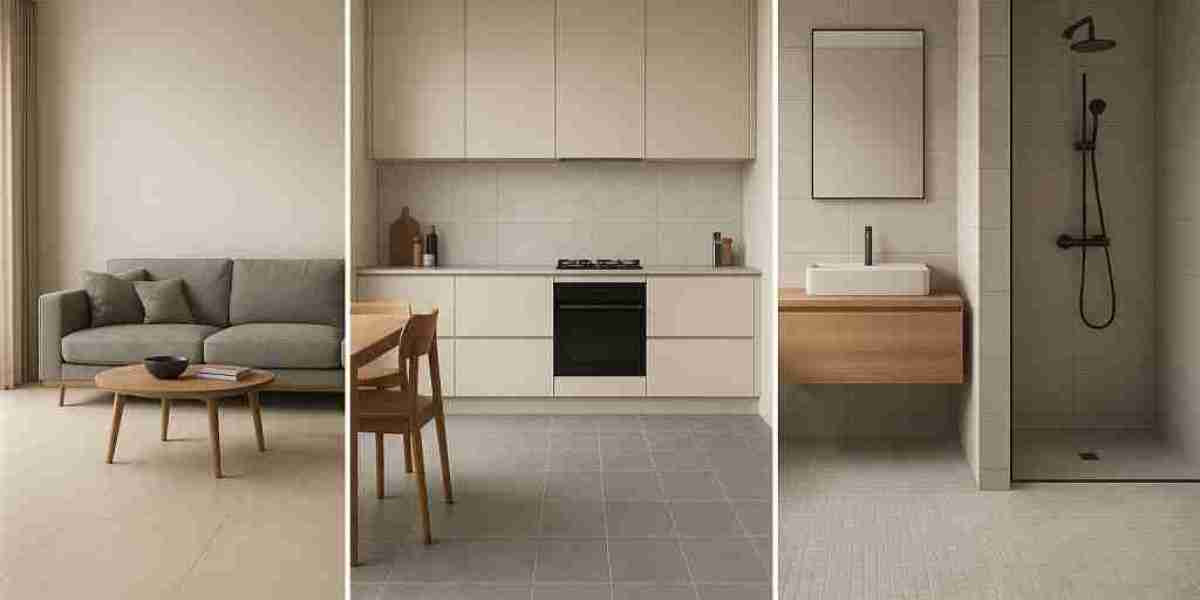Tile size is a pivotal design choice that shapes a room’s look, feel, and functionality. The right dimensions can make a space feel larger, cleaner, and more cohesive, while the wrong ones can disrupt balance or complicate installation. This guide provides insights on selecting tile sizes for every room, installation considerations, and why a ceramic tile shop is a vital resource for smart choices.
Why Tile Size Counts
Tile size affects aesthetics, maintenance, and installation demands. Large tiles create a seamless, modern surface with fewer grout lines, simplifying cleaning. Smaller tiles add texture, grip, and intricate patterns, ideal for detailed or high-slip areas. Your choice should reflect the room’s use, surface conditions, and design vision. A ceramic tile shop provides hands-on samples to explore size options.
Living Rooms and Open-Plan Areas
In large living rooms or open-plan homes, big tiles often work best. Sizes like 600x900 mm, 800x800 mm, or 1200x1200 mm slabs create a unified floor that enhances spaciousness. These tiles suit sleek, contemporary designs, particularly in porcelain. However, large tiles need a level subfloor to prevent issues like cracking. Have your installer check the surface and visit a ceramic tile shop to find tiles and adhesives that fit your needs.
Kitchens: Function Meets Style
Kitchens require tiles that handle spills and heavy traffic while maintaining style. Medium to large sizes, like 400x400 mm or 600x1200 mm, reduce grout lines for easy cleaning and a polished look. In spill-prone areas like near sinks, smaller tiles (100x200 mm) or mosaics add traction through extra joints. For heated floors, confirm thermal compatibility at a ceramic tile shop to ensure performance.
Bathrooms: Mixing Sizes for Effect
Bathrooms thrive with a blend of tile sizes. Large wall tiles (600x900 mm) create a spacious, elegant vibe, while medium floor tiles (300x600 mm) balance style and stability. In wet zones like showers, small tiles or mosaics (25x25 mm or 50x50 mm) provide grip and conform to drainage slopes. A ceramic tile shop can demonstrate how to mix sizes effectively through sample layouts.
Small Rooms and Corridors
In compact spaces or narrow hallways, tile size can shift perception. Large tiles with minimal grout lines make small rooms feel bigger, but they’re harder to fit in tight corners. Rectangular tiles (200x1000 mm or 300x900 mm) laid lengthwise elongate narrow spaces like corridors or small bathrooms. Test orientations at a ceramic tile shop to see how size and layout affect the room’s flow.
Outdoor Spaces and Balconies
Outdoor tiles must withstand weather and prioritize safety. Large pavers (600x600 mm or larger) give patios a modern, streamlined look, but the base must be stable. For balconies or wet areas, medium tiles (300x300 mm to 400x400 mm) with anti-slip textures are practical. Check slip ratings and weather resistance at a ceramic tile shop to select durable tiles.
Backsplashes and Accent Walls
Feature areas like backsplashes or accent walls offer creative flexibility. Small tiles or mosaics (50x50 mm or smaller) add detailed patterns, perfect for kitchen backsplashes. Large slabs (800x1600 mm) create a bold, seamless effect in living rooms or behind stoves. For patterned tiles, view full-scale samples to ensure balance. A ceramic tile shop often has displays to inspire your design.
Grout’s Design Impact
Grout lines shape a room’s aesthetic. Contrasting grout highlights tile edges, creating a grid-like pattern, while matching grout blends seams for a sleek look. Rectified tiles allow for thin joints, ideal for large formats. Discuss grout options with your ceramic tile shop to match your style and maintenance preferences.
Installation Challenges
Tile size impacts installation complexity. Large tiles require a flat surface, quality adhesives, and sometimes leveling systems for precision. Smaller tiles are easier to install on uneven surfaces but take longer due to more cuts and grout. Poor installation risks cracks or loose tiles, so choose skilled professionals. A ceramic tile shop can suggest products and installers for your project.
Budget and Waste Management
Tile size affects costs and material waste. Large tiles may lead to more offcuts in complex layouts, while smaller tiles fit irregular spaces but increase labor time. To save money, ask a ceramic tile shop in Singapore for layout planning or sample cuts to estimate waste. They can also provide cost breakdowns, including installation.
Before You Purchase
Test tiles in your home’s lighting. Bring samples from a ceramic tile shop to check color and scale. Lay them out to assess proportions and confirm edge finishes. Verify specs like slip resistance, wear ratings, and water absorption. A reliable ceramic tile shop offers full-size samples and expert guidance to finalize your choice.
Closing Thoughts
Choosing tile size requires balancing style, function, and installation realities. Consider the room’s purpose, size, and surface conditions. Large tiles create openness, small tiles add detail, and the right mix elevates any space. Visit a ceramic tile shop to explore samples, plan layouts, and get expert advice, ensuring your tiles enhance your home’s beauty and livability.




